
The .40 S&W (10.2×22mm) is a rimless pistol cartridge developed jointly by American firearms manufacturers Smith & Wesson and Winchester in 1990. The .40 S&W was developed as a law enforcement cartridge designed to duplicate performance of the Federal Bureau of Investigation's (FBI) reduced-velocity 10mm Auto cartridge which could be retrofitted into medium-frame semi-automatic handguns. It uses 0.40-inch-diameter (10 mm) bullets ranging in weight from 105 to 200 grains.

The .45 ACP, also known as .45 Auto, .45 Automatic, or 11.43×23mm is a rimless straight-walled handgun cartridge designed by John Moses Browning in 1904, for use in his prototype Colt semi-automatic pistol. After successful military trials, it was adopted as the standard chambering for Colt's M1911 pistol. The round was developed due to a lack of stopping power experienced in the Moro Rebellion in places like Sulu. The issued ammunition, .38 Long Colt, had proved inadequate, motivating the search for a better cartridge. This experience and the Thompson–LaGarde Tests of 1904 led the Army and the Cavalry to decide that a minimum of .45 caliber was required in a new handgun cartridge.

The .380 ACP, also known as .380 Auto, .380 Automatic, or 9×17mm, is a rimless, straight-walled pistol cartridge that was developed by firearms designer John Moses Browning. The cartridge headspaces on the mouth of the case. It was introduced in 1908 by Colt, for use in its new Colt Model 1903 Pocket Hammerless semi-automatic, and has been a popular self-defense cartridge ever since, seeing wide use in numerous handguns. Other names for .380 ACP include 9mm Browning, 9mm Corto, 9mm Kurz, 9mm Short, and 9mm Browning Court. It should not be confused with .38 ACP. The .380 ACP does not strictly conform to cartridge naming conventions, named after the diameter of the bullet, as the actual bullet diameter of the .380 ACP is .355 inches.

The .357 SIG is a bottlenecked rimless centrefire handgun cartridge developed by the Swiss-German firearms manufacturer SIG Sauer, in cooperation with ammunition manufacturer Federal Premium. The cartridge is used by a number of law enforcement agencies.
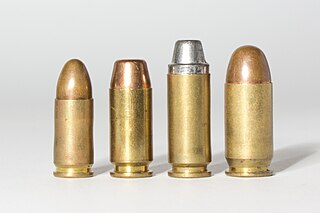
The 9×19mm Parabellum is a rimless, centerfire, tapered firearms cartridge.
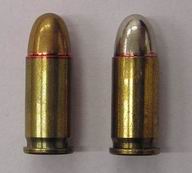
.32 ACP is a centerfire pistol cartridge. It is a semi-rimmed, straight-walled cartridge developed by firearms designer John Browning, initially for use in the FN M1900 semi-automatic pistol. It was introduced in 1899 by Fabrique Nationale, and is also known as the 7.65 mm Browning Short.

The .38 Super, also known as .38 Super Auto, .38 Super Automatic, .38 Super Automatic +P , .38 Super +P , or 9×23mmSR, is a pistol cartridge that fires a 0.356-inch-diameter (9.04 mm) bullet. It was introduced in the late 1920s as a higher pressure loading of the .38 ACP, also known as .38 Auto. The older .38 ACP cartridge propels a 130-grain (8.4 g) bullet at 1,050 ft/s (320.0 m/s), whereas the .38 Super pushes the same bullet at 1,280 ft/s (390.1 m/s). The .38 Super has gained distinction as the caliber of choice for many top practical shooting competitors; it remains one of the dominant calibers in IPSC competition.

The 10mm Auto is a powerful and versatile semi-automatic pistol cartridge introduced in 1983. Its design was adopted and later produced by ammunition manufacturer FFV Norma AB of Åmotfors, Sweden.

The .44 Smith & Wesson Special, also commonly known as .44 S&W Special, .44 Special, .44 Spl, .44 Spc, or 10.9×29mmR, is a smokeless powder center fire metallic revolver cartridge developed by Smith & Wesson in 1907 as the standard chambering for their New Century revolver, introduced in 1908.
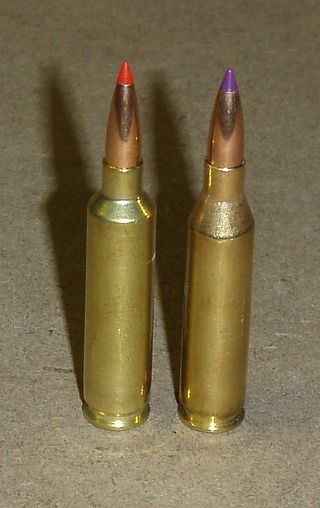
A wildcat cartridge, often shortened to wildcat, is a custom-made cartridge for which ammunition and/or firearms are not mass-produced. These cartridges are often created as experimental variants to optimize a certain ballistic performance characteristic of an existing commercial cartridge, or may merely be intended as novelty items.
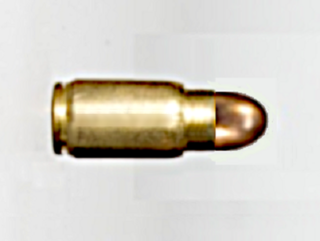
The .25 NAA is a pistol cartridge introduced by the North American Arms company in 2002. It was originally created for use in a smaller and lighter model of their Guardian pistol.
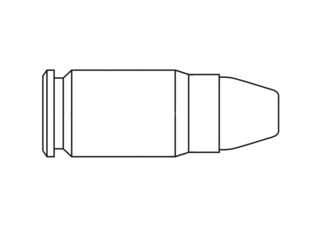
The .32 NAA is a cartridge/firearm 'system' designed and developed by the partnership of North American Arms and Corbon Ammunition. The cartridge is a .380 ACP case necked-down to hold a .32 caliber bullet with the goal of improved ballistic performance over the .32 ACP.

Cor-Bon/Glaser LLC is a manufacturer of small arms ammunition.

The .41 Action Express is a pistol cartridge developed in 1986 to reproduce the performance of the .41 Magnum police load in semi-automatic pistols.

The 9×25mm Dillon is a pistol wildcat cartridge developed for use in USPSA/IPSC Open guns. The cartridge is made by necking down a 10mm Auto case to 9 mm.

The .38/.45 Clerke, aka .38/.45 Auto Pistol, .45/.38 Auto Pistol, or 45/.38 Hard Head, is a wildcat semi-automatic pistol cartridge developed by Bo Clerke and introduced in Guns & Ammo in 1963.
The .40 Super (10.2x25mm) is a powerful automatic pistol cartridge developed through the collaboration of Fernando Coelho and Tom Burczynski and introduced by Triton Cartridge in 1996. It delivers ballistics comparable to the .41 Magnum revolver cartridge, yet functions in standard 1911s and other full-size pistols. A 5” 1911 chambered in the cartridge is capable of penetrating 46” of Clear Ballistics gel.
The .500 S&W Magnum or 12.7×41mmSR is a .50 caliber semi-rimmed revolver cartridge developed by Cor-Bon in partnership with the Smith & Wesson "X-Gun" engineering team for use in the Smith & Wesson Model 500 X-frame revolver and introduced in February 2003 at the SHOT Show. From its inception, it was intended to be the most powerful handgun cartridge to date, with the capacity to harvest all North American game species. While more powerful handgun cartridges, such as the .500 Bushwhacker, have emerged since, they are only available in custom firearms, and the .500 S&W remains the most powerful production handgun cartridge.
9mm Major, also known as 9 Major, ammunition is loaded much hotter than typical 9mm rounds, exceeding 1,550 ft/s (470 m/s) to achieve a power factor of 165. This classification benefits competition shooters maximum magazine scoring. However, it is not readily available and dangerous to use in pistols not designed for such high pressure. Many handgun manufacturers that use plastic internal parts will caution against using +P and +P+ ammunition and 9mm Major loads, which generate even higher chamber pressures. In tactical situations, velocity improves vest penetration, if not designed properly, it will affect hollow-point projectiles' behavior. It is important that the bullet be designed to expand and stop within the threat to maximize energy transfer. Col Fackler of the Army Ballistic Wound Lab studied this phenomenon extensively. The bullet needs to create a permanent wound channel, not a temporary one like most hollow-points and ball ammo. Proper cartridge design is crucial for optimal performance.

















